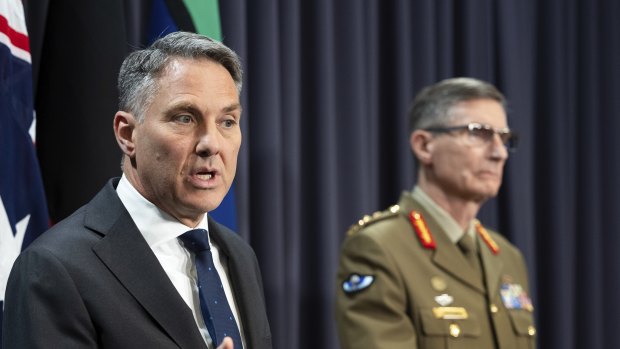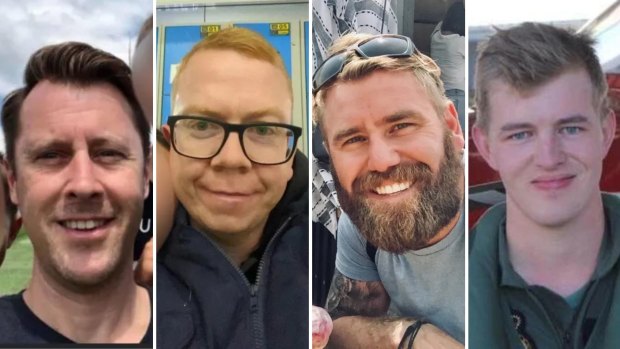By Matthew Knott and Ben Cubby
The federal opposition is calling on the government to speed up the retirement of the troubled fleet of MRH-90 Taipans after it was confirmed that four army aircrew members had died after their helicopter crashed off the Queensland coast.
As debate intensified among defence experts about whether the main problem was the helicopters or a maintenance issue, Defence Minister Richard Marles announced the search-and-rescue mission off the Whitsundays had become a recovery mission.
“There was a catastrophic incident and, with every passing hour, it is now clear that any hope of finding Captain Lyon, Lieutenant Nugent, Warrant Officer Laycock and Corporal Naggs alive has been lost,” Marles said.
The families of the four aircrew were notified by the government on Monday morning.

Defence Minister Richard Marles and Chief of the Defence Force General Angus Campbell said there was no longer any hope the missing service members would be found alive.Credit: Alex Ellinghausen
Marles said that “significant wreckage” from the MRH-90 Taipan helicopter had now been recovered from the search site and “it is clear there was a catastrophic impact of the helicopter when it hit the water”.
“There will be a full investigation and we shouldn’t be speculating about the accident beyond the fact that it was catastrophic,” Marles said.
Prime Minister Anthony Albanese paid tribute to the deceased service members, telling parliament: “They dedicated their lives to keeping us safe. They were soldiers, sons, husbands, brothers, fathers and friends. Today, our deepest sympathies are with the people who love them and the people that they love.”

From left: Warrant Officer Class 2 Joseph “Phil” Laycock, Corporal Alexander Naggs, Troop Commander Captain Daniel Lyon and Lieutenant Maxwell Nugent.
The Taipans have been plagued with technical problems during their term of service, and the fleet of 47 aircraft was suspended from use in March when one of the helicopters crashed into shallow waters off Jervis Bay on the NSW south coast.
Opposition defence spokesman Andrew Hastie said he hoped the Taipans could be replaced by a $2.8 billion fleet of Black Hawks from the United States before the scheduled date of December 2024.
“I do not think that can come soon enough, frankly,” Hastie, a former Special Air Service captain, told the ABC.
“From a Coalition perspective, we would support the expedition of [the Black Hawk] into service.”
Graham Wild, a senior lecturer in aviation technology at the Australian Defence Force Academy, said of the Taipans: “From an operational point of view, according to people in the ADF, they’ve not been a great fit-for-purpose helicopter from the beginning.”
He added that, while the aircraft has been plagued by technical problems, its overall safety record was similar to that of other helicopters operated by military forces around the world.
Wild said Taipans had been involved in three accidents during their service, equating to one serious incident for every 25,000 flying hours including Friday’s crash.
Across the same time period, the larger CH-47 Chinook has averaged one accident every 30,000 flying hours, the S-70 Black Hawk one accident every 35,000 hours and the Tiger attack helicopters once every 30,000 flying hours.
“The Australian Defence Force in terms of aviation safety is the envy of the world,” Wild said.
Michael Shoebridge, director of military consultancy Strategic Analysis Australia, said he did not expect the army to fly the Taipans again given the length of time the full investigation into Friday’s crash will take.
While noting long-running technical problems with the helicopter, he added: “Talisman Sabre, the exercise the crash occurred in, is a deliberately realistic, high-end military exercise. That means the ADF people, helicopters, ships, aircraft and ground forces are involved in orchestrated and realistic manoeuvres. These involve risk if they are to be realistic.”
Marles said the families of the deceased service members “face the prospect ahead of a life with an unfillable hole”.
“To them we are so deeply sorry, and we are so deeply grateful,” he said. “And they have every right to feel an intense sense of pride.”
Australian Defence Force Chief Angus Campbell said: “We’re going to do everything possible to bring our mates home to their families.”
Campbell said the investigators were seeking to recover as much as possible of the helicopter’s airframe, and possibly data recording systems, to help determine what occurred on Friday.
“The investigation, like all accident investigations, we will scrutinise every aspect of this event,” he said.
Campbell declined to comment on reports from Whitsundays residents that they had heard mayday calls following the crash, saying: “Anything to do with the investigation is easily distorted in perception by any comment that I might make or any other official or indeed by the media.”
Writing in trade publication Asia-Pacific Defence Reporter after Friday’s crash, editor Kym Bergmann contended that the Taipan’s poor maintenance record could be blamed on poor logistics and spare parts management by the defence force rather than inherent problems with the aircraft themselves.
“The reality is that there have always been plenty of spare parts available,” Bergmann wrote. “What has stopped them getting from the warehouse to multiple workshops has been burdensome bureaucracy caused mainly by outdated Defence software.”
Army chief Simon Stuart said on Sunday that the entire Taipan fleet had been grounded following Friday’s accident during the Talisman Sabre war-gaming drills, adding the army would not use the aircraft again “until we think it is safe to do so”.
Asked whether he expected the retirement date to be brought forward after Friday’s accident, Stuart said: “The aim is still 2024. What happens between now and then from what we learn from this incident is yet to be determined. We just need a bit of time.”
Cut through the noise of federal politics with news, views and expert analysis from Jacqueline Maley. Subscribers can sign up to our weekly Inside Politics newsletter here.